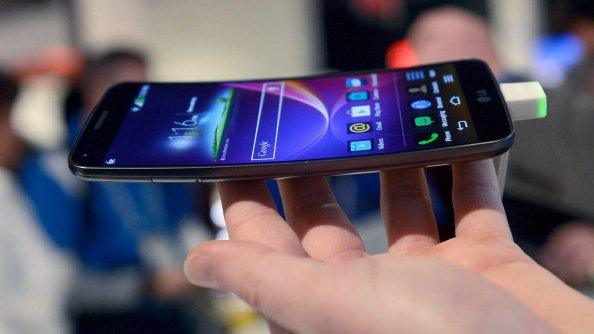CES 2015: TV makers redefine 4K battleground
- Published
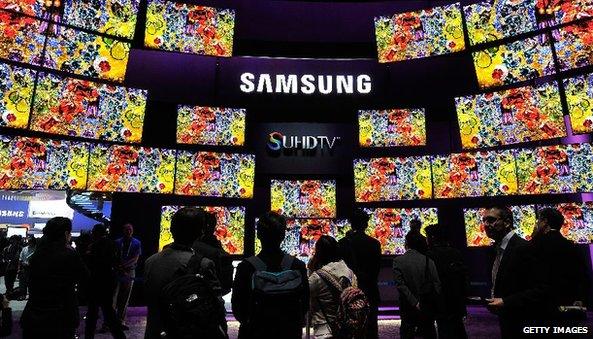
4K televisions at CES were thinner, brighter and bigger than ever before
Samsung has declared that by 2017 every television it sells will be internet-connectable, prompting one of its executives to suggest we'll soon stop referring to "smart" TVs as such because net-enabled services will be the norm.
Well, maybe.
But even if that's true it doesn't mean it's getting any easier for shoppers to make sense of all the different options being pitched at them.
Press day at this year's Consumer Electronics Show (CES) saw a number of new buzz words tossed about.
The only things each of the various manufacturers seemed to agree on at the Las Vegas show, beyond the fact that consumers should upgrade to 4K ultra-high definition sets - offering four times the detail of 1080p HD - was that each of their own technologies was the best.
OLED v quantum dots
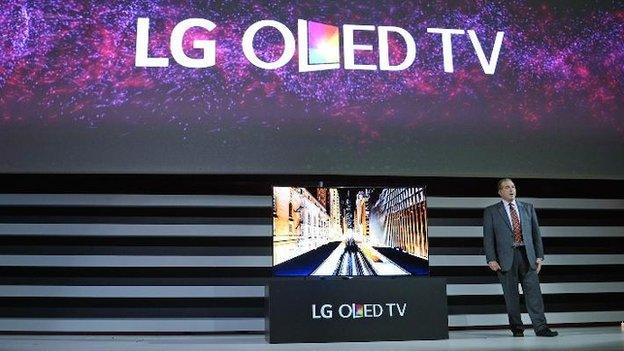
LG says it recently invested $600m to boost OLED TV production
The most fierce clash is between the two bestselling brands - LG and Samsung.
Bosses at LG's morning event repeatedly stated that they had the edge thanks to their expertise in making OLED (organic light-emitting diode) TVs, which are famed for displaying deeper blacks, producing more vibrant colours and being more energy efficient than traditional LCDs (liquid crystal displays).
LG has seven new OLED sets for sale in its refreshed line-up, including a giant 77in (196cm) flexible model that can switch between being flat and curved at the press of a button.
By contrast, Samsung has had trouble manufacturing OLED sets and hasn't released new ones at CES as a consequence.
So it is kind of convenient that instead Samsung has a different new technology to show off that it claims delivers even better images thanks to superior contrast levels.
It calls the innovation SUHD - the S presumably standing for Samsung.
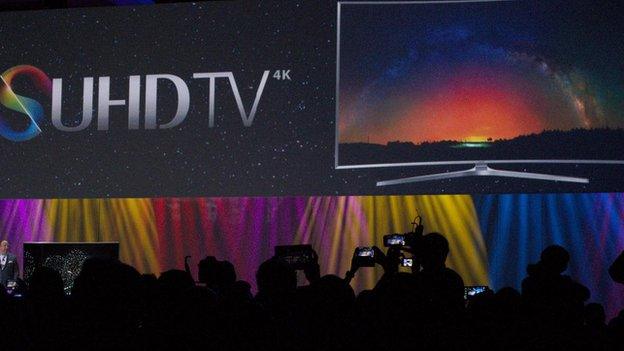
A demo SUHD TV showed much deeper blacks than a traditional LCD television
It involves the South Korean firm's first application of quantum-dot tech - screens that feature crystals more than 50,000 times smaller than the width of a human hair that can generate vivid colours and are capable of being more than twice as bright as conventional TV screens.
To complicate matters, LG also has new quantum-dot-based LCD TVs of its own, but insists its OLED ones are better.
Until independent experts carry out their own side-by-side tests, it's impossible to say which of the two firms is right.
But one expert suggested that even if OLED wins out, the format might still be doomed, at least for TVs.
"Price will rule," says Tom Parsons, reviews editor at Stuff magazine.
"If there's only really one manufacturer working on OLED, you've got to wonder if it will be able to champion it enough that it can bring prices down.
"If the picture quality of quantum-dot-based sets is roughly as good and they are cheaper, then cost will be the deciding factor for most people."
Subpixel bonanza
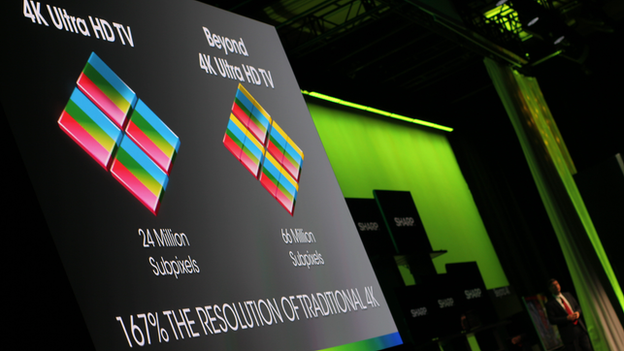
Sharp's new 4K technology involves adding extra subpixels to the image
Japan's Sharp is taking a different approach, with a new technology it has dubbed "beyond 4K".
It works by squeezing more "subpixels" into its set than others do.
A normal TV's pixel is made up of three subpixels - one red, one green and one blue
Sharp adds a yellow subpixel to the mix and then divides each of the four subpixels in two, allowing the TV to control each of the resulting eight subpixels individually
The result is a 4K TV with a total of 66 million subpixels instead of the usual 24 million
The firm says that with this level of detail our eyes find it hard to distinguish a TV image from the real world, even when stood centimetres from the display. It's like looking through a window.
Of course, that's not how most people typically watch the goggle box. But one expert noted that habits are changing.
"The reality is that the bigger TVs get, the closer people are willing to sit so long as the definition continues to improve," says David Mercer, a TV expert at the consultancy Strategy Analytics.
"And what we're already finding with ultra-HD is that people are sitting proportionally closer to the screen than they would for lower resolutions."
New app platforms

Sony's latest range of 4K TVs will be powered by Google's new Android TV software
If you've managed to get your head round all that, be warned the work is not done.
The other move at this year's CES is that the TV makers are making huge changes to the smart TV software they use to offer streamed programmes and apps:
Samsung is switching all its sets to Tizen - a Linux-based operating system it already uses on some smartwatches and cameras
Sony, Philips and Sharp are adopting Google's new Android TV platform
Panasonic is releasing its first TVs powered by Mozilla's Firefox OS in the Spring
In fact, of the big players, only LG is staying relatively still, upgrading its sets to the second generation of WebOS - the card-based user interface it bought from HP. The new version loads apps a bit quicker and adds supports for 4K video streams.
Elsewhere, some of the smaller brands, including Haier, have adopted Roku's platform, originally designed for add-on set-top boxes.
"Increasingly a lot of these companies are realising you need to have the benefit of a big third-party ecosystem that embraces developers," says Geoff Blaber from the CCS Insight tech advisory firm.
"App usage on smart TVs is nowhere near what we've seen on smartphones and if the TV players want to encourage people to engage in regular upgrades, then they need the hook of more apps."
4K disks
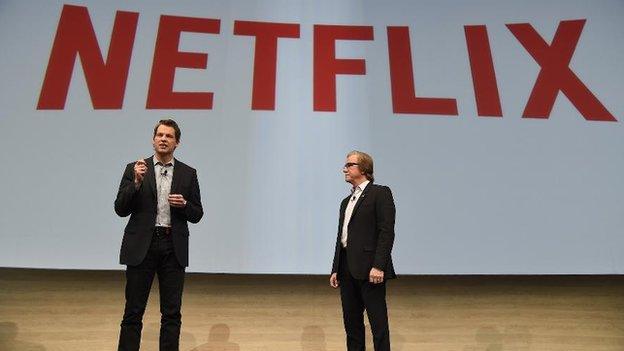
Netflix was one of the first firms to provide 4K TV owners with access to ultra-high definition video
Finally, there's one more consideration. Where are you going to get your ultra-high definition content?
Netflix and Amazon have started to stream some shows in the higher definition format, and new TVs are gaining the ability to stream 4K YouTube clips.
But if you want the very best quality your latest-generation set can provide, you might want to wait for a bit of tech briefly shown off by Panasonic - a prototype 4K Blu-Ray player.
"There's an enthusiast market for the very best in video and audio material, and disks will be a very good way to deliver that content," says Mr Mercer.
"If the industry can get its act together and bring the standard to market soon, then it has potential. But the window is beginning to close as the momentum is very much towards video on-demand over the net."
So, you need to pick the screen tech you want, compare the different prices after they are confirmed, choose a preferred operating system and finally decide how you want to obtain your 4K movies and TV shows.
Just don't take too long about it.
"The lesson we've learned from smart TV over the past five years is that at one CES you'll hear one set of stories, and when you come back a year later the firms have a completely different pitch for you," concludes Mr Mercer.
"It's a very fluid sector."
Click here for more coverage from the BBC at CES 2015, external
- Published6 January 2015

- Published5 January 2015
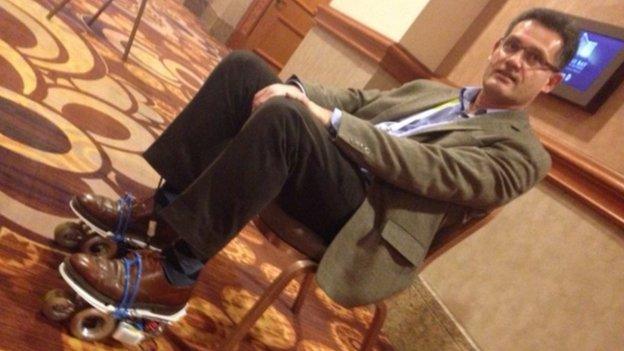
- Published5 January 2015
